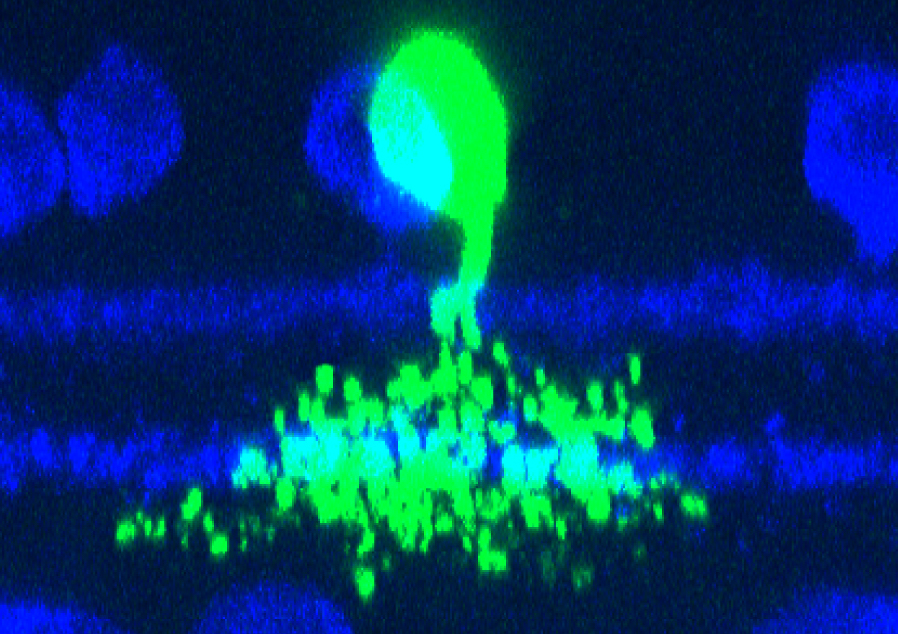
Investigators have discovered a new subtype of interneurons in the retina that allows the eye to see and identify objects better in both the light and in the dark, according to a Northwestern Medicine study published in Nature Communications.
The findings dismantle previous notions about the inner workings of the eye and also have broader implications for informing future neuroscience research, according to Yongling Zhu, PhD, assistant professor of Ophthalmology, of Neuroscience and senior author of the study.
In a mammalian eye, the retina converts light into electrical signals that the optic nerve then sends to the brain, enabling vision. Before being transmitted to the brain, the electrical signals are processed in a dense, synaptic layer within the retina, which is divided into two halves.
For decades, the scientific community had believed that neurons make synapses in one-half of the synaptic layer respond when light is turned on, and in the other half when light is turned off. However, Zhu’s team recently discovered a new subtype of interneurons called amacrine cells that carries an “off” signal even when situated in the “on” half.
“The ‘on’ and ‘off’ division is considered to be the fundamental organizing plan of the retina; however, our study has discovered an exception to this organization plan,” Zhu said.

Amacrine cells are inhibitory interneurons within the retina. They act as traffic controllers for visual signals, traveling from photoreceptors that detect light to ganglion cells in the retina that then relay electrical signals to the brain. But systematically studying amacrine cell subtypes has only recently become possible thanks to advancements in genetic technologies.
“Each subtype possesses a unique shape and genetic profile, and they form connections with other neurons in distinct and specialized ways. Studying these cells has been exceptionally challenging, mainly due to the absence of genetic tools that would allow for the labeling or manipulation of specific subtypes,” Zhu said.
In the current study, Zhu’s team employed a new genetic approach, an “intersectional strategy,” which involves labeling and isolating amacrine cell subtypes in mice retinas that express two unique proteins, which can identify more restricted cell types than by labeling for just one protein.

To the investigators’ surprise, they identified a previously unidentified subtype of amacrine cell that establishes synapses in the ”on” half of the synaptic layer but functions as the cells typically found in the “off” half.
Using fluorescent sensors to track the cell’s behavior, in conjunction with genetic and pharmacological interventions, they also found that these cells use an inhibitory glutamate (neurotransmitter) receptor called mGluR8 instead of an excitatory glutamate receptor called AMPA, which is expressed by all other amacrine cells, to receive electrical signals.
In this way, the new amacrine cells act as a switch, by converting an incoming excitatory signal into an inhibitory signal before transmitting it to downstream neurons and finally to the brain, Zhu said.
“This particular amacrine cell is not only a new kind of neuron, but it also exhibits a new way of conveying information from one half of the retina layer to the other. This information transfer increases the sensitivity of retinal neurons to detect objects in the dark and enhances their ability to distinguish different motions in the light,” Zhu said.
Going forward, Zhu said her team aims to improve their intersectional strategy to achieve single-cell type labeling and to follow up by determining how this amacrine subtype impacts different visual pathways and downstream neurons.
“There are about 60 different types of amacrine cells. They’re all very specialized, all have a different function, all are very difficult to access, and the technique that we have developed can be used on each one, one at a time… Now we have a way, a really robust way of going from one to the next,” said Steven DeVries, MD, PhD, the David Shoch, MD, PhD, Professor of Ophthalmology and a co-author of the study.
Andrew Jo, PhD, a former student in the Northwestern University Interdepartmental Neuroscience (NUIN) program, was lead author of the study.
This work was supported by National Institute of Health grants R01 EY030169, R01 EY018204, R01EY032506 R01, R01 EY012141, EY029985, F31 EY031985, a Whitehall Foundation Grant and funding from Research to Prevent Blindness.






